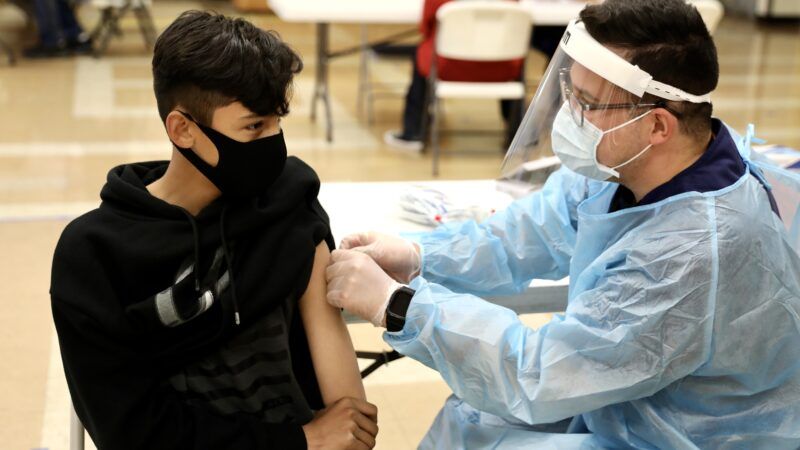Vaccine Mandates Coming for K-12 Students
San Diego becomes latest school district to require teen jabs. But is it good policy?

The San Diego Unified School District Tuesday night voted unanimously to require students age 16 and over to be fully vaccinated by December 20 or be exiled into remote learning.
The country's 21st largest school district thus joins #2 Los Angeles (whose guidelines cover everyone 12 and up), and smaller Culver City, California (also 12+), as the earliest adopters of what will likely be an increasing—and increasingly controversial—trend of mandating injections into the arms of comparatively low-risk minors.
"Tonight we're making a statement that we believe in the science, we believe in the process and that we are serious about this, that we want to protect children," School Board Vice President Sharon Whitehurst-Payne said at the meeting.
Whitehurst-Payne's interpretation of the science is not universal. Dr. Vinay Prasad, of UC San Francisco's Epidemiology & Biostatistics department, noted in a U.S. News & World Report column Tuesday that different countries have come to different conclusions about the safety of giving kids two doses rather than one, and that potential side effects of myocarditis (heart inflammation) are real, if rare.
"Taking kids who decline vaccination and preventing them from getting an in-person education is a draconian penalty," Prasad wrote. "Prolonged school closures have massive negative effects on children, robbing them of education, the last tattered rung left in the ladder of American opportunity….[T]he reality is they are overstepping the certainty of the science, and they are taking out our collective rage and frustration—that this pandemic has not yet ended—on children. It is a shameful policy, and I condemn it."
K-12 student vax mandates are almost certain to jump beyond the borders of California. Education Secretary Miguel Cardona last Thursday said that he "wholeheartedly" supports them. New York Governor Kathy Hochul has said repeatedly this month that she's keeping a student-mandate open as an "option."
According to an article this week in Pew Trusts, "Officials in counties and cities in California, Maryland, New York and Virginia as well as the District of Columbia are mandating vaccinations—with a few exceptions for weekly testing—for student-athletes. Hawaii has a statewide vaccine requirement for public school student-athletes." But also: "At least 12 states ban schools from requiring vaccines for students."
As has been the case with COVID-related policies on masking, school reopening, business closures, and vaccine passports, a chief determinant on whether a given polity mandates or bans K-12 vaccines is not the comparative impact of the coronavirus, but rather which of the two major political parties constituents favor. That means the higher your vaccination rates are for minors, the more likely you are to pass a student vax mandate.
The United States' one-shot vaccination rate for 12- to 17-year-olds is currently around 57 percent. California is at 68 percent, New York at 66 percent…and then there are the states that have banned student mandates: Florida (55 percent), Utah (55), Arizona (53), Arkansas (47), Oklahoma (44), Montana (42), Tennessee (37), and Alabama (36). Assuming for the sake of argument that vaccine mandates are an unalloyed good, the states that need them most will almost certainly get them least.
But the argument over mandates is anything but settled. COVID-19, even since the triumph of the delta variant and the advent of vaccination, has remained overwhelmingly an older-person disease: Just 478 people under the age of 18 have died of it through Sept. 29, according to the Centers for Disease Control and Prevention (CDC). That's less than the 643 minors that the CDC estimates died during the 2017-18 winter flu season. Rare is the state that mandates flu shots; though in fairness, their effectiveness rate lags far behind those of the three COVID-19 vaccines approved in the U.S.
The second main reason to favor the physical removal of unvaccinated students is to keep kids from spreading the virus to teachers and staff. But school employees have had priority access to vaccines for more than half a year by now. Given the microscopic infection results revealed by school testing—0.27 percent among the unvaccinated in New York City, around 0.6 percent in Los Angeles—it's reasonable to continue concluding that school buildings are among the safest places for humans to gather in groups.
Like all vaccine mandates, K-12 student requirements will surely drive up vaccination rates, and thus hasten the virus's transition from pandemic to endemic status. But by how much, and at what cost?
Kids who are sent back home for yet another year marred by remote learning will experience tangible and measurable harm, including the possibility of being more, not less, exposed to COVID-19. Their parents' work productivity, comparatively, will suffer.
Speaking as a parent of a fully vaccinated 13-year-old in public school, I do not fear her unvaxxed classmates (if she has any), and I'd rather any such students be regularly tested than be sent packing. But as usual, my educational preferences will be drowned out by the people I choose to live among.
A "science" whose policy extrapolations depend on political slant will continue to lose public respect. Advocates who don't acknowledge and grapple with real-world tradeoffs will almost certainly introduce major error. Vaccines are a marvel of modern medicine, and the best ticket out of the wretched last 19 months of our lives. But that doesn't mean it's wise for the government to force this particular one on teenagers.
Related Reason reading, from 2014: "Should Vaccines Be Mandatory?: A libertarian debate on immunization and government."


Show Comments (331)